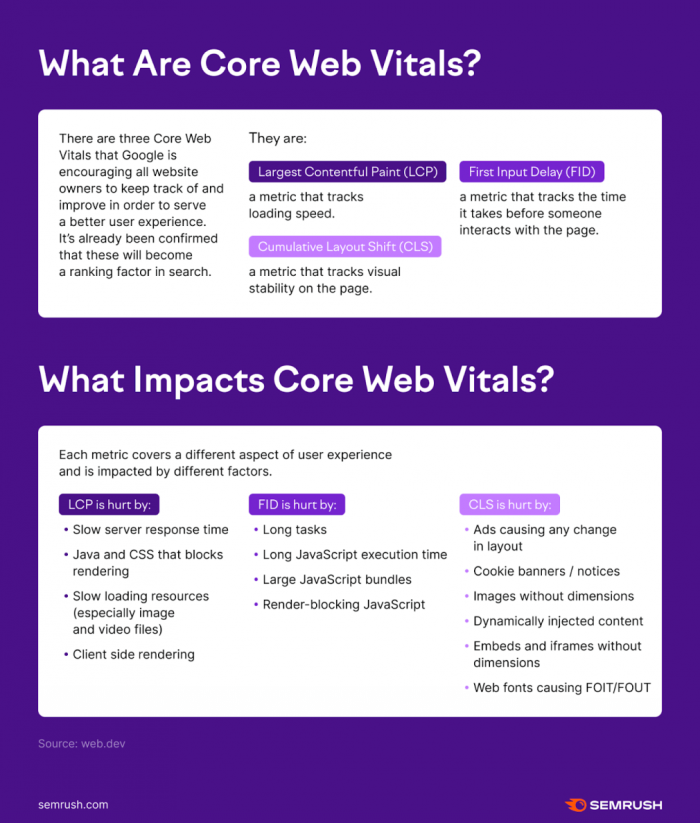2021 was a pretty challenging year. And travel, inflation, and health regulations weren’t the only things that went through a lot of changes.
The SEO landscape — never known to be stable or very predictable — has also witnessed a lot of shifts: some of them were well-anticipated, and some came as a surprise.
But one thing remains certain: they are likely to stay with us in years to come, so, love it or hate it, you will have to embrace them.
Curious about which SEO trends exactly are we talking about here? Read on!
Top SEO Trends to Master in 2022
1. Digest and Adopt to all the Search Updates and Google Algo Changes That Took Place Back in 2021
It’s every SEO’s job to keep up with the pace of the ever-changing search landscape. So a bunch of Google Algo updates is nothing new.
But 2021 came with some ground-shattering shifts, which you will have to get used to and adapt in the upcoming year:
- The Page Experience Update and the arrival of Core Web Vitals
Site speed and user experience. These words should dominate your SEO strategy in the upcoming year. You probably knew this before, but now, with the Page Experience Update and Core Web Vitals metrics that impact your rankings, you have to do everything you can to ensure lightning-fast load time for your pages and meet the Core Web Vitals thresholds.
Source: Semrush blog
Wonder how to even get to checking your Core Web Vitals and get ready for the Page Experience update?
This page has done a great job covering how to optimize your pages for the Core Web Vitals.
- E-A-T is back
If your site should embrace the speed and UX principles, your content efforts should be guided by another three: Expertise, Authoritativeness, and Trustworthiness.
These three elements now determine what Google considers to be a quality page (aka quality content).
It means that it’s now getting harder and harder to prove to Google that your pages are worth the top ranks. It’s no longer just about keywords or even simply (as if it was so simple) meeting user intent.
While Google now takes a more holistic view when determining your rankings, you can still do a few things to make sure you’re sending strong E-A-T signals to the search engine:
- Link back and get backlinks from trustworthy and high-quality domains.
- Show relevancy to your audience by catering content that matches their preferred formats — if you’re tackling teens, for instance, videos would be the right way to go.
- Invest in brand-building so that your site becomes the it-destination within a given niche.
2. Catching User Intent Will Be More Important Than Ever
Back in 2021, we all said our goodbyes to BERT and welcomed MUM or Multitask Unified Model.
This is Google’s updated way to process users’ search queries — all to bring them the most relevant and holistic information possible to meet their searches with the most all-rounded content.
MUM simply means that Google is now even better equipped to understand users’ real intent, and hence you can’t ‘cheat’ the search engine with keyword stuffing or any other tricks that used to work back in the days.
With no more language or format barriers, Google will now take into account all the content available on the subject matter, including podcasts, videos, images, etc., and make its search results peak based on the richness of the delivered content, and based on its more in-depth understanding of what the user is really searching for.
While high-quality content is still the way to go and is the only way to ensure your pages get those rankings, you need to place some extra effort into understanding user intent.
Given this, Semrush’s latest user intent analysis will come in handy — whenever you use Semrush’s keyword analysis or research tools, you will not get insights into each keywords’ intent. Give it a shot — it can really help you be better equipped for the MUM update.
Source: Semrush Keyword Magic Tool
On top of intent, you will have to work harder on finding the top semantically related keywords.
Because, once again thanks to MUM, Google is now better than ever at understanding the context of people’s searches, and the only way to grasp that is to understand and tackle that context yourself.
So while primary keywords are still very important, the secondary ones are “secondary” no more. Your 2022 content strategy should be built around semantic search and intent optimization because Google doesn’t simply look at the string of words.
For this, you will need a reliable and very comprehensive tool that will deliver all the information you need to tackle semantic search and craft content that actually addresses users’ queries.
If you don’t have a tool for all things keywords yet, I’ll share my personal favorite: Semrush. With the widest keyword database out there, it’s actually the only toolkit in town that has keyword intent analysis. And my readers have a unique chance to get a free 14-day trial of the entire toolkit.
Related content: Semrush review
3. You Will Have to Trigger Rich Results and Featured Snippets
For years, Google has been turning more into a destination point rather than a simple search engine that delivers search results. This is where the concept of SERP marketing comes in.
Knowledge graphs, extended answers (think of the ‘people also ask” box), visual results — all of the Google SERP features tie into the notion.
If you type in something like “Yosemite” into the search bar, you’ll barely see any organic search results:
So your organic presence, although still very crucial, might get lost in-between the richness of the SERPs.
And the further we go, the more prominent these SERP Features get.
The same goes for rich snippets — images, star-based reviews, prices, and other chinks of information that might not show up for competing pages, help you stand out from the crowd.
So, love it or hate it, you will have to work on implementing structured data and other ways to trigger featured snippets and ensure rich snippets.
It’s not an easy job, but armed with the right intel and tool, you can unwrap which snippets are yet not taken by your rivals and implement the right structured data to take over the SERPs.
Source: Semrush Organic Research tool
4. Video Should Be a Part of Your 2022 SEO Strategy
For a long time, video was more of a UX thing or something you would think of if you planned on relying on YouTube marketing.
But now, with video forecasted to dominate over all other forms of content consumption, it’s also a part of SEO.
Interestingly, when I typed in “2022 SEO trends”, the top results were all video (which probably means this post could use a support of a video):
2021 Google I/O was full of video feature announcements — we have two new video-related structured data, namely, Seek Markup and Clip Markup that are supposed to help your video content to show up across the SERPs.
These are Key Moments-like features, but if the former is only available for videos uploaded to YouTube, the other two are applicable for any videos.
This means that video SEO does not now only apply to optimizing our YouTube videos for the internal search engine of the video giant, it’s actually a way to show up on Google’s SERPs thanks to correct implementation of structured data.
Just the way other rich snippets and featured snippets work.
5. Optimize Your Images, Because They Rank
For a long time, we’ve been hearing that image search is coming. And in 2022, it is already here.
As much as textual content is here with us to stay, and some even predict that long-forms will be gaining more traction with Google, people love visual content, and visual search is the next it-thing.
It’s not just a way to look at images — visual search is about obtaining information, and it’s also a lot more commercial, triggering product purchases.
So if you never took alt attributes seriously, 2022 is the time to do so — from proper file names and labeling to high-quality images and alt tags, you have to give users and crawlers proper marking and signals that help to classify images in search.
Over to You
Surprised not to see your usual “voice search and mobile search are the next searches”?
Well, all search is now mobile search, and it’s not something that happened overnight throughout 2021. The same goes for voice search. If you aren’t yet ready for those – we were already talking about it back in 2018 – following the 2022 SEO trends we covered here won’t help your SEO strategy in the upcoming year.
But if you’re fully mobile-ready, then with search moving towards contextual relevance, a better understanding of the human language and intent, as well as expansion into other content formats, you have to ensure the following:
- High-quality content that meets user intent and provides real answers to actual questions people are posing.
- High-authority sources — whoever you are referring to, has to be a reliable and authoritative source. And if you have a backlink from one of those, that’s just a dream come true.
- Versatile content formats — videos and images are making their way into SERPs, and with people giving more and more preference towards the visual mediums, Google search will be giving more real estate to other types of content.
- Don’t forget about the technical stuff: site speed, UX, structured data will all play a key role in your SEO strategy in years to come. This means that you need a regular site audit to make sure your site is performing the best it can at any given moment.

João Aguiar
Head of Digital at Mobidea
João is the Editor-in-Chief at Mobidea Academy, a tech player, dynamic, proactive, and fun! When he's not focusing on his role, he enjoys eating tasty food.
Understand which are the 11 SEO trends and predictions to keep an eye on in 2018 and improve your performance in the game!
Learn how to effectively research keywords taking Google's Algorithms into account and become a true SEO pro!
A comprehensive guide on how to find, use and buy expired domains with high authority.










